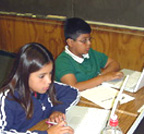

 |
|
 |
|
|
|
|
|
|
|
|
|
|
|
|
Instructional Objectives:
Students will access the Internet and research an assigned Native
American cultural group.
Social Studies
5.1 Students describe the major pre-Columbian settlements, including
the cliff dwellers and pueblo people of the desert Southwest,
the American Indians of the Pacific Northwest, the nomadic nations
of the Great Plains, and the woodland peoples east of the Mississippi
River.
1. Describe how geography and climate influenced the way various
nations lived and adjusted to the natural environment, including
locations of villages, the distinct structures that they built,
and how they obtained food, clothing, tools, and utensils.
2. Describe their varied customs and folklore traditions.
3. Explain their varied economies and systems of government.
Time required: Approximately
two 45-minute periods
Advance preparation and prerequisite knowledge and skills: The students should be familiar with the concept that the various Native American tribes, though different in many ways, can be grouped according to their similarities such as language and their manner of finding food, and how these similarities were influenced by their specific environment and geographic area. The participants should also have some experience accessing the Internet and navigating web sites for research. They should also know how to cite resources for their bibliography.
Materials and resources required: A computer for every two students with Internet access is necessary for this activity. Copy the organizational chart on which the students will take notes while researching. Click here for chart.
Vocabulary:
Environment: Everything around us; mountains, valleys,
rivers, lakes, deserts, and forest. The weather is part of the
environment as well as the people, animals and plants surrounding
us.
Native Americans: The first Americans, thought to have
crossed the Bering Strait land bridge from Asia to North America
between 28,000 and 10,000 B.C. in search of food.
Native American Cultural Groups: Groups of Native Americans
that anthropologists and archeologists have devised. They are
classified according to their similarities such as language and
their manner of finding food. Some common groupings are: Eastern
Woodland Hunters, Central Plains Hunters, Northwest fishermen,
Southwest Farmers, and the California Seed Gatherers.
Procedures: Assign students to one of the
five cultural groups. Form partnerships for Internet Research and eventually
for writing the book. Review organizational chart and discuss headings and what
kind of information should be noted. Remind students about citing Internet resources
This site is an excellent resource for citing sources: http://tekmom.com/cite/index.html
Provide the following list of sites for the students to use in their research:
http://kidinfo.com/American_History/Native_Americans.html
A very comprehensive list of links to sites with information on North American
tribes, selected for students. Start here.
http://germantown.k12.il.us/html/intro.html
A simple website written by third graders with links to the five cultural groups
http://yahooligans.com/Around_the_World/Countries/United_States/Cultures_and_Traditions/Native_American/A
list of links on Native Americans
Activities:
Students will:
· Explore the various web sites
· Fill in the organizational chart as they find information
· Cite sources
· Consult with their partners about any division of labor
or to share information
Evaluation: Review organizational
chart and proper citing of sources and note cooperation in pairs.
Homework: Each student will
take home the social studies text and, using the index, find information
about their cultural group.
Extension: Students will design a table using Microsoft
Word and enter the data for all the cultural groups.
Student Work Samples: Click
here for samples